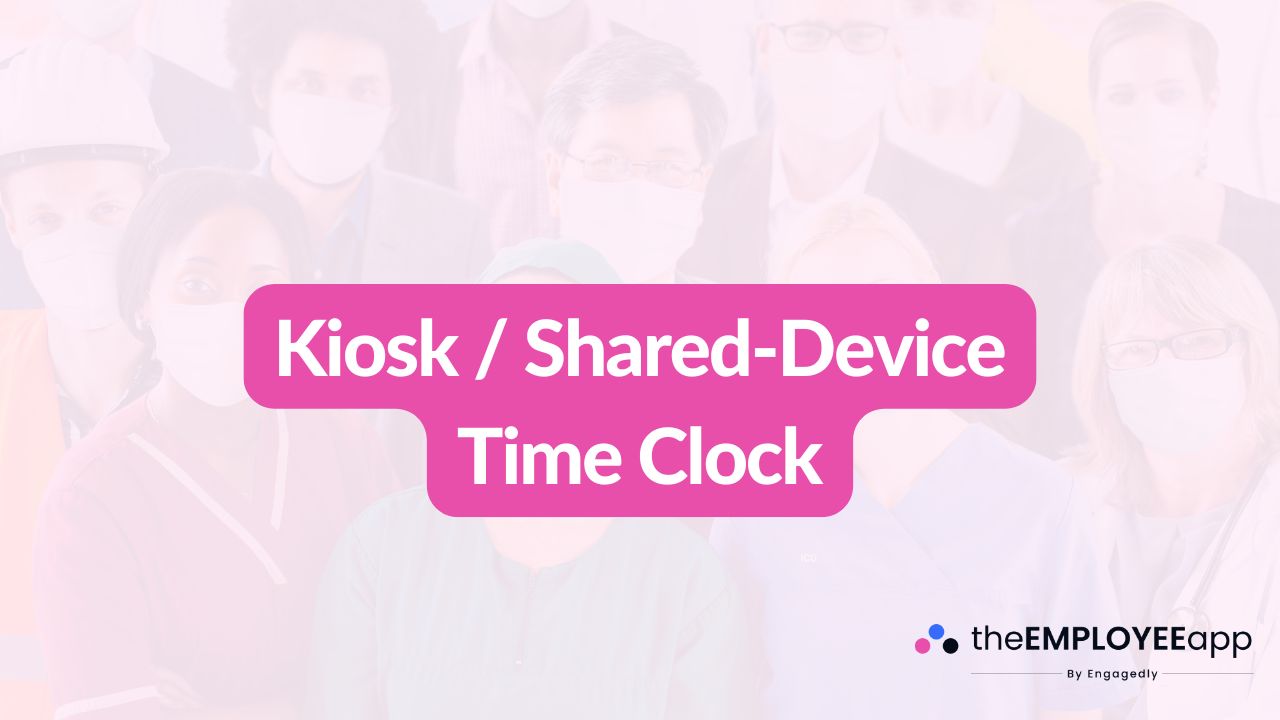
A kiosk or shared-device time clock is a centralized system that allows multiple employees to clock in and out using a single device. Commonly placed in high-traffic areas like entrances, breakrooms, or near worksites, kiosk-based time clocks ensure accurate attendance tracking and streamline workforce management, especially for frontline teams.
This approach eliminates the need for every worker to have an individual device, making it cost-effective and easy to implement in industries with large or shift-based workforces.
A kiosk time clock is a digital or physical terminal where employees record their work hours. Instead of carrying personal devices, employees use a shared screen, tablet, or mounted kiosk to clock in and out. Modern kiosk solutions are typically software-driven and can run on tablets or computers, providing flexibility and reducing hardware costs.
With the rise of mobile and cloud-based technology, kiosk time clocks can integrate seamlessly with payroll, scheduling, and HR systems, giving organizations a more efficient and accurate attendance process.
Central Device Setup
Employers install a kiosk, usually a tablet or shared computer, in a convenient location.
Employee Authentication
Workers identify themselves using methods like PIN codes, employee IDs, RFID cards, QR codes, or even facial recognition.
Clock-In and Clock-Out
Once authenticated, employees can record their work start and end times directly through the shared device.
Automatic Sync
The system logs the data in real-time, connecting with payroll or scheduling tools for accuracy and compliance.
Cost-Effective
Instead of equipping every employee with a mobile app or device, one shared kiosk can serve an entire team.
Prevents Buddy Punching
Advanced kiosks use biometrics or photo verification to ensure only the correct employee is clocking in.
Streamlined for Frontline Workers
Perfect for environments like retail stores, warehouses, or healthcare facilities where employees pass through central locations.
Integration with Workforce Systems
Attendance data flows directly into payroll and scheduling systems, reducing manual errors and saving time for managers.
Scalable Across Locations
Organizations with multiple sites can deploy kiosks at each location, centralizing all data into one platform.
Retail: Employees clock in at a store entrance kiosk, ensuring consistent records across multiple shifts.
Hospitality: Hotels use shared-device time clocks for housekeeping and front-desk staff.
Healthcare: Nurses and aides clock in at shared stations within a hospital or clinic.
Manufacturing & Warehousing: Teams working in shifts clock in at shared devices on the production floor.
Construction: A site-based kiosk allows workers to record hours without needing personal devices.
While kiosk and shared-device time clocks are highly effective, organizations should be mindful of:
Device Crowding: During peak times, such as shift changes, multiple employees may need to clock in at once, creating bottlenecks.
Sanitization Needs: In industries like healthcare or food service, shared devices must be regularly cleaned.
Connectivity Requirements: Kiosks require stable internet or network access to sync data in real-time.
These challenges can be addressed through multiple kiosk setups, staggered shifts, touchless technologies, and strong IT infrastructure.
Frontline employees often work in fast-paced, shift-driven environments where accurate time tracking is critical. Kiosk time clocks ensure fairness and accuracy by preventing missed punches, reducing payroll disputes, and protecting against time theft.
They also empower managers with real-time attendance data, making it easier to adjust staffing, track compliance with labor laws, and support operational efficiency.
The next generation of kiosk time clocks is moving toward biometric verification, touchless scanning, and AI-powered attendance tracking. These innovations will make shared-device time clocks even more secure, user-friendly, and resistant to fraud.
As frontline industries continue adopting digital workforce tools, kiosks will remain a reliable, scalable, and cost-effective solution for managing employee time and attendance.
A kiosk or shared-device time clock is a practical and efficient solution for frontline organizations that need accurate, centralized, and secure time tracking. By combining ease of use with powerful integrations, kiosks reduce errors, save costs, and improve workforce management.
For industries where employees don’t have individual devices, kiosk systems offer a dependable way to modernize attendance tracking and boost operational efficiency.
